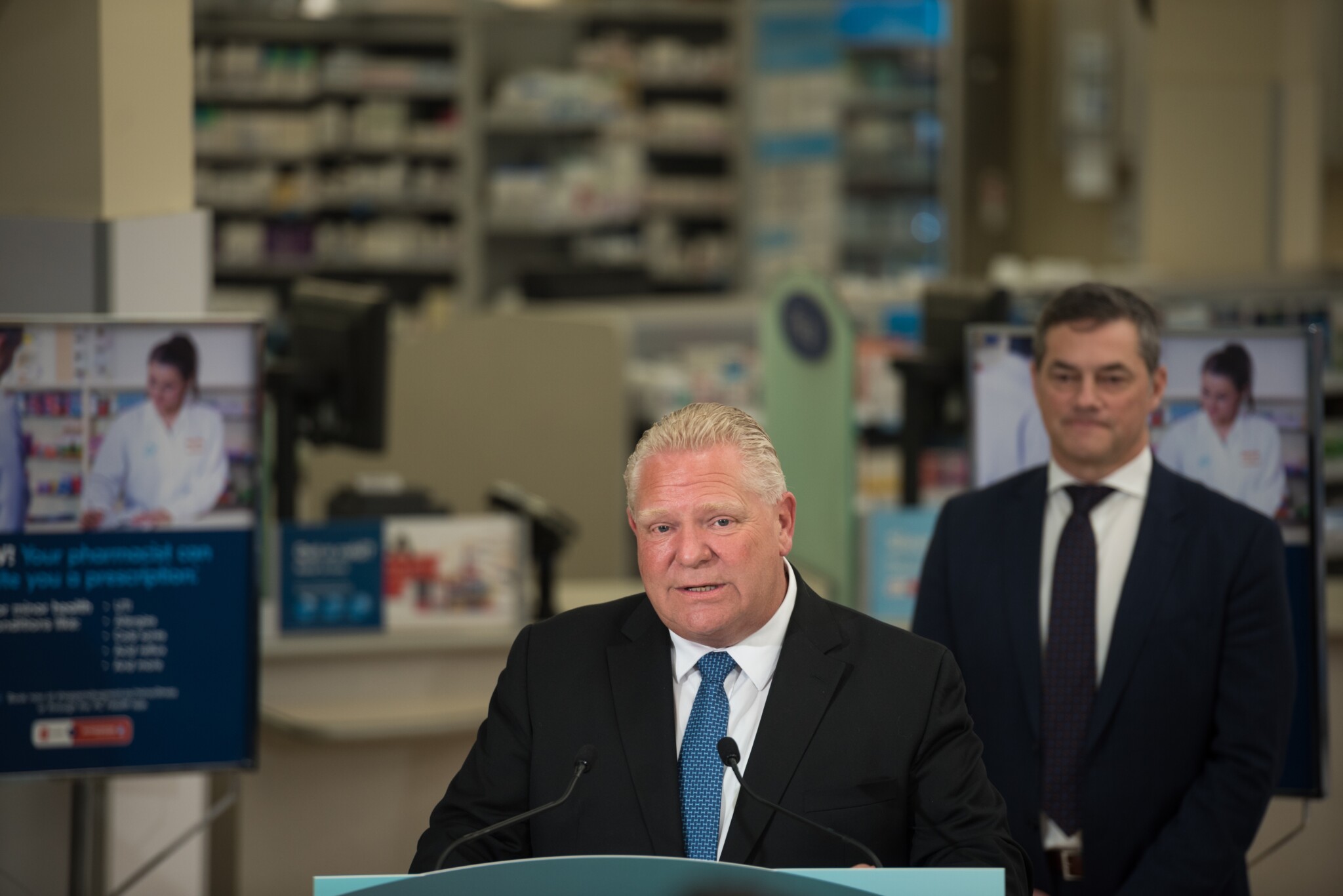
After a “lost decade” of stagnant incomes, rising crime, government failures on basic functions like health care and immigration, and a once-in-a-generation affordability crisis driven by inflation, a majority of Canadians believe that Canada is broken. But decline is a choice, and better public policies are needed to overcome Canada’s many challenges. Kickstart Canada brings together leading voices in academia, think tanks, and business to lay out an optimistic vision for Canada’s future, providing the policy ideas that governments need to ensure a bright future for all Canadians.
Before this summer’s premiers’ meeting, Ontario’s Doug Ford wanted to make delays in access to prescription medicines a key issue. His spokesperson said “To ensure Canada maintains its advantage as a leader in health care innovation, we…need to get new publicly funded medicines to people as fast as possible. Currently, patients in Canada wait almost two years to access life-saving breakthrough medicines, a year longer than in other developed countries.”
In a letter to the pan-Canadian Pharmaceutical Alliance (pCPA), which negotiates drug prices for Canada’s governments with manufacturers, Ford said: “Canada currently ranks last in the G7 in the time it takes to approve and provide patients access to innovative and often life-saving medicines. This needs to change. We owe it to Canadians to do everything we can to give them the same timely access to life-changing treatments as patients in the rest of the world.”
Premier Ford, head of the second largest government in this country, is right. Canadians suffer and die as a result of delays in accessing new life-changing and life-saving medicines. But Canadian governments, including Ford’s own, are the main problem.
Multinational drug makers submit their drugs for regulatory approval to more populous countries, such as the U.S., the European Union, and Japan, before applying to Health Canada. In most other countries when medicines are approved, approval applies to the whole country or, in the case of the European Union, all member states. Moreover, once approved by the U.S. Food and Drug Administration, a drug can enter the American market straightaway.
In Canada, to be funded through government drug plans, a medicine must receive approval from Health Canada for safety, efficacy, and quality, and then go through a health technology assessment (HTA) by the Institut national d’excellence en santé et services sociaux in Quebec and/or Canada’s Drug Agency (CDA)—formerly known as the Canadian Agency for Drugs and Technologies in Health—for the rest of Canada. They recommend whether a drug should be reimbursed by government drug plans. Their processes take too much time.
CDA claims the “typical timeline” for its HTAs is 180 days or less, but no drug was reviewed within this time in 2021, 2022, and 2023, or so far in 2024. The real timeline is about 10 months, not six. The data submitted to Health Canada for regulatory approval of a drug’s efficacy and safety are frequently the same as in the submission to CDA, plus a pharmacoeconomic analysis. When CDA reviewers doubt a drug’s clinical benefit, as they commonly do, they are duplicating and second-guessing much of the work already done by Health Canada and delaying patient access.
Following a positive recommendation from CDA, drug developers must then wait to be invited by the pCPA to negotiate the price and other factors with this collective government drug plans’ agency governed by a board of provincial and territorial drug plan executives. Again, this takes time. Furthermore, CDA reviews regularly recommend a significant price cut, which can exceed 70 percent, to achieve cost-effectiveness based on multiple assumptions and a low, out-of-date, and unrealistic cost threshold not used by HTA agencies elsewhere. Price cuts recommended by CDA set up a bargaining position for the pCPA. Demands for huge price cuts discourage reasonable negotiations.
The pCPA aims to decide whether to negotiate within 40 business days of a CDA recommendation being issued and its goal is to achieve this 90 percent of the time. However, for cancer drugs introduced over the past decade, 90 percent of the pCPA’s decisions on whether to pursue a price negotiation took up to six to seven months, not two. For anyone with an aggressive cancer, this delay is life-threatening and entirely the responsibility of the pCPA, because manufacturers play no role in its decision process.
The pCPA also aims to complete 90 percent of negotiations with manufacturers within 90 business days (about four calendar months). Negotiations depend on both parties being fully engaged in arriving at a fair agreement in a timely fashion. Manufacturers wanting to sell their drugs have every incentive to keep the process on track. However, 90 percent of the pCPA’s price negotiations for cancer drugs in the past decade were completed within 10 months, not four. Again, such delays can be life-threatening for those with an aggressive cancer. Similar delays occur in the reviews of drugs for rare disorders, many of which must be administered as early as possible in sufferers’ lives to be most beneficial.
Delays in patient access don’t end with a CDA recommendation and a successful pCPA negotiation. Government drug plans, which control the pCPA and dominate CDA, aren’t mandated to fund drugs that successfully surmount the barriers of HTAs and price negotiations. Drug developers have to negotiate further with individual federal, provincial, and territorial government drug plans to be included in their benefit lists, which can take months and, in some cases, years. Even when drugs are added, conditions for patient access may be so onerous that few patients qualify for access.

Kirsten Watson poses with take-home cancer drugs at her home in Waterloo, Ont., Feb. 23, 2024. Peter Power/The Canadian Press.
There is yet another hurdle for timely access: the Patented Medicine Prices Review Board (PMPRB). No other comparable country has a similar quasi-judicial tribunal whose role is to assess whether a drug’s price is “excessive.” It’s a unique Canadian experiment in federal government gatekeeping. Between 2017 and 2022, the PMPRB tried to extend its role to deciding whether a drug’s price is “unreasonable,” but Canadian courts ruled that this was beyond federal authority. The PMPRB is now re-establishing itself, but its role has been superseded by the pCPA so that it is now obsolete, except for a tiny minority of Canadians without access to public or private insurance. It is to be hoped that the PMPRB doesn’t continue to try to force price reductions by regulation because this only deters and delays developers from launching new medicines in Canada.
With all these government-controlled disincentives and failed opportunities to speed up new drug access, is it surprising that drug companies don’t prioritize bringing innovative medicines to Canada?
To make a real difference, our governments should, as a growing number of countries do, make new drugs needed by Canadians available before and while HTAs and other assessments are pursued, especially for fatal and seriously debilitating disorders that have no other effective treatment. This would allow earlier access and provide Health Canada and CDA with valid real-world evidence on the effectiveness and safety of drugs, which is usually not included in submissions to CDA because it rarely meets the review criteria. We see no sign of any leadership on this deficit in health care. Patients and health care providers are more appropriate to decide on benefits and risks than an HTA organization trying to predict the benefits of drugs in everyday clinical practice from highly controlled premarketing trials that don’t represent real-world practice. It’s an apple-to-orange contrast, with easy-to-see shortcomings.
Sadly, change is unlikely to occur. While the U.S. and European and other countries establish processes to accelerate access to new drugs, Canada’s premiers came up with blather in their meeting communique:
“Premiers remain fully committed to ensuring all Canadians receive the care they need through effective health care systems across the country, funded appropriately by the federal government. Premiers also agreed to continue to focus on health care innovation and discussed the importance of accelerating patient access to new and life saving publicly funded medicines and committed to further work in this area.”
Canadians need action, not such platitudes, to kickstart a more healthy future.
Clearly, without a larger clinician and patient voice, Canadians are in for more of the same—not a progressive strategy to get innovative medicines to Canadians who need them. Canada’s premiers need to put their own houses in order and prioritize Canadians’ access to new beneficial drugs as early as possible—not, as is the case now, years after their approval by Health Canada.








